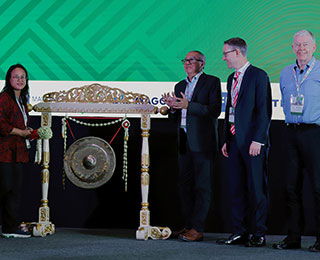Cement Grinding Plant of the Year – Aliénor Ciments (Cem'In'Eu)
Company representatives
Sébastien Didier-Laurent, technical director, Aliénor Ciments and Cem’In’Eu (France)
Company description
Aliénor Ciments is the first in a network of cement grinding plants being installed across Europe by newcomer Cem’In’Eu. In contrast to large production units built far away from their customers, Cem’In’Eu aims to construct small units in the heart of the markets, meeting immediate local demand. A second grinding plant is due to open in France’s Drôme department in 2020, followed by units in Maine-et-Loire, Chalon sur Saône and the port of Ottmarsheim. Overseas projects include plants in northern Poland and the UK.
Project description
Aliénor Ciments is a 0.24Mta cement grinding plant located at Tonneins, between Bordeaux and Toulouse, France. Its modular design enables it to be constructed quickly and efficiently, with the aim of serving a delivery radius of 200km. The plant features a number of innovations designed to protect the environment and sit in harmony with the local community.
The site
The site for the plant was selected due to its strategic location between the two large French cities of Bordeaux and Toulouse. The plot, which is just under 3ha, is an old industrial site that had been unused for 20 years. However, its location very close to housing areas, required an exceptional collaboration with the local community to gain acceptance for the project.
The build
The first tenders were put to bid in 2016 with the EPC contract for the construction of the ball mill and separator awarded to InterCem Engineering GmbH of Germany the following year. By the middle of 2017, the final contract for the design was completed and construction began in January 2018. Due to its modular design, the plant was built quickly and finally commissioned on 7 July 2018.
Logistics
The plant is located on the main Toulouse-Bordeaux railway line with existing branches leading to vacant sidings, one of which is exclusively for use by Aliénor Ciments. Clinker arrives at the site by train from Bassens, a multimodal terminal in the port of Bordeaux. To support its clinker logistics, Cem’In’Eu has built a 60,000t clinker storage yard at the Mediterranean port of Sète in Southern France, under the name of Cem’In’Log, allowing gypsum or clinker to be transported directly to the plant by rail, the most efficient means of transport in terms of CO2 per t/km.
A bespoke container-based transport system means the clinker can be moved without any possibility of dust. Upon arrival each container is lifted individually by an automated overhead crane and loaded into the discharging position at an angle over the discharge bin, enabling a full train of 42 containers carrying 1.35t of clinker each to be unloaded and reloaded in less than five hours. The clinker discharge bin is surrounded by a heavy-duty dust curtain to contain spillage and dust emissions.
Once the clinker has been dumped in the bin, it is scooped up by the Volvo 4700I wheel loader and deposited in the clinker storage bin. The Tonneins site has sufficient capacity to store 4500t of clinker, limestone and gypsum, in addition to liquid Chryso additives needed to reduce the chromium VI content in the limestone from 6ppm to 2ppm, as well as improving clinker grindability and final product strength.
Production
Once materials reach the dosing units in the mill building, they are correctly proportioned and fed into the 30tph, two-compartment ball mill. The mill uses around 105t of Vega grinding balls to grind the clinker. Conscious of the plant’s location in an urban area, to reduce the noise of the grinding process, the mill building is covered in a special cladding to lower noise pollution by 32dB to 82dB when the mill is in operation. In terms of emissions control, air compressors are used to move material and any dust is contained. The plant is equipped with a Scheuch baghouse with 6.5m-long bags for dust capture. There is also a stack which only emits waste air from the process and dust is kept below 20mg/Nm3.
The plant currently produces three types of cement for sale within the EU. The onsite laboratory ensures the final product is compliant with both French and European standards. The laboratory is equipped with Ametek analysers to carry out quality control in terms of clinker and additives used.
Packing and transport
The finished product is transported by an Aumund bucket elevator to six 500t Orhand cement silos fitted with Ingesoa extraction systems. Around a third of cement sales from the plant are bagged. Haver & Boecker’s Adams bagging equipment cuts and welds the fully-recyclable and waterproof polyethylene bags, supplied by RKW Group. With 10 filling spouts, the packer is able to fill 1100 bags of 35kg/h. A Newtec Araus 1200P palletiser currently loads the bags but Aliénor Ciments plans to upgrade its packing section to produce palletless bundles of cement bags to reduce weight and costs. Key to this step is the OMS stretchood wrapper to enable palletless wrapping.
In the truck loading area, trucks are loaded by the driver due to a fully automated system supplied by Ibitek, which also installed the DC5 mill production control system. The truck loading area also features Aerzen Delta blower compressors and a Haver Niagara feed pusher for filling.
The rail line can also be used to send finished products to market.
